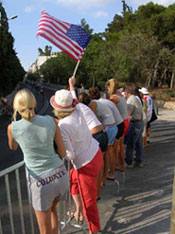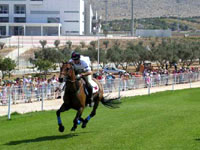
WEB JOURNAL FROM 2004 ATHENS OLYMPICS
 August 15, 2004
August 15, 2004
Athens
7:00 PM
Caption: US fans cheering at Women's Bicylce Race, with Irene Romano waving the flag! Photo: DGR.
This morning we took the Metro from a northern suburban station to the center of town to watch the Women’s Cycling Race. The Athens Metro has been built and opened within the past 10 years, but several new stations have been added and are just opening now in the past few weeks for the Olympic Games. We left from one of these newest stations today with workmen still putting the finishing touches on the entrance and the signs. The Metro subway cars are clean and bright and many of the stations feature archaeological exhibits of the material found when digging the Metro Stations. These are wonderful exhibits, featuring the artifacts, sometimes in situ, along with photographs, drawings, plans and explanations. These are among the great new modern museums of Athens.
When we arrived in the center of the city, we found the streets to be closed for the race and barriers in place. The Athenians were clearly out of town for this Sunday afternoon. The day itself has been sunny with a constant breeze, clouding up in the late afternoon, for a coolish evening. We visited with friends as we watched the race go by on the street outside. Keeping track of the race on television (Euro Sports Channel) and then watching in person out the front door (see photograph)was a great way to keep track of the race. The women rode 9 laps of a city course or a total of 118.8 km. The race was punctuated by an accident at the end of the 7th lap when the defending champion, Leontien Zijlaard-Van Moorsel of the Netherlands was involved in a crash. The winner was Sara Carrigan of Australia.
An exciting afternoon!
DGR
 August 17, 2004
August 17, 2004
Athens
6:30 PM
Caption: Philip Dutton of Australia riding Nova Top during the Cross Country Competition of the Mixed Team Eventing competition.
We have spent the last two days at the Olympic Equestrian Center, a new facility that has been built in Markopoulou, an area to the northeast of Athens, near the new international airport. It is a place which until only a few years ago was a fairly remote area of Attica, known for agricultural produce, mostly olive oil and wine. Now, as well as the construction of the huge new airport, a modern equestrian center has been built, with several different stadiums and a cross country course for equestrian competitions. The center occupies a large area and has been constructed in and around olive groves and fruit trees. Yesterday we watched the Dressage (one of three days of Mixed Team Eventing also including Cross Country and Jumping) and today we watched Cross Country. Both the Dressage and the Cross Country are absolutely beautiful events to watch (see photo). The stands are by no means full; I would estimate that less than 50% of the seats were filled during the Dressage and headlines here are talking about the low spectator turnout for the games generally. During the Cross Country events today there were no seating facilities as the spectators walked along the sides of the attractive course to watch the riders. Mixed Team Eventing is an interesting event in which men and women compete against each other on equal terms, and in which the horse as well as the rider receives a medal for first, second and third place.
The ancient Olympic Games included equestrian events as an important part of the athletic schedule. They featured different kinds of events, two and four horse chariot racing, horseback racing, and specialty events for young horses, etc. They even had a chariot race for mules for about 50 years. The four horse chariot race may have been the most exciting of all the ancient athletic events at Olympia. Kings, tyrants and emperors often competed in these equestrian events. In antiquity the owner of the horse was the victor, and he (or she on a few occasions) did not even need to be at the site of Olympia during the race. Such was the case in 356, 352 and 348 B.C. when Philip II (father of Alexander the Great) won three equestrian victories at Olympia.
Bus transportation brought us to the Equestrian Center from the airport and we had taken the new Suburban Train from our area of town to the airport. This train has just begun service in the past month and it is absolutely fabulous! The Suburban Train is a different service than the Metro which is also fabulous. During the Olympic Games travel on public transportation is free for Olympic spectators (as long as you show your ticket for the day). There are many corporate reminders as you enter the Olympic Equestrian Center. The official Olympic water is AVRA, the official soft drink is Coca Cola. One may only charge with Visa, no Mastercard and no American Express.
Olympic souvenirs are absolutely everywhere! There are the national flags, as well as several varieties of Olympic flags, pins, hats (lots of hats!) mugs, cups, stuffed animals, especially featuring Athena and Phoibos, the two mascots of the games, shirts, pants and towels. For kids especially there are backpacks, folders, notepads, pencils, pens and photobooks. There are Official Olympic stores at the Olympic venues as well as around town. Visitors from different countries often come with their own national hats, shirts, and sometimes colorful costumes!
DGR